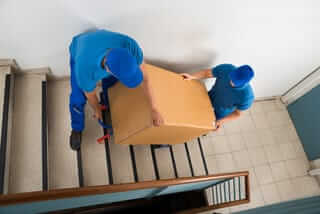If you consider taking a piano with you as you move to a new place, then it’s probably more than just a musical instrument for you. Most likely, it’s your sentimental treasure or a cherished family heirloom.
But with their majestic size and delicate inner workings, moving a piano is no small feat. It requires careful planning, finesse, and a set of very strong hands. Doing it yourself might seem like a money-saving option, but the risks involved could hit the wrong note.
We put out this article from the perspective of our professional movers to help you better understand whether your resources and capabilities are enough to carry out the piano moving process on your own. Our experts have also brought together moving tips that will help you achieve a hassle-free piano move.
Understanding the complexity of a piano
Each piano has its own personality and charm. And of course, unique complexities. So, before we dive into the details, let’s take a moment to see what makes these musical instruments so special.
The weight and delicate nature
Firstly, the sheer size and weight of a piano make it a substantial moving challenge. Depending on the type, a piano can weigh anywhere from 300 to 1,200 pounds. That’s as heavy as a full-grown polar bear.
But despite their robust exterior, pianos are delicate. They house a complex arrangement of hammers, strings, and keys. Each of these components requires gentle handling to prevent damage and ensure the piano maintains its perfect pitch.
The many types of pianos
There are several types of pianos, and moving each has its own challenges.
For instance, grand pianos can be up to 9 feet long. They have a wing-like shape, which doesn’t make their relocation any easier. Moving a grand piano involves special equipment and technique due to its size and the delicate, horizontally-strung strings.
Upright pianos are more compact. So, they are a common choice for homes and small spaces. However, don’t be fooled by their size — they can still weigh between 200 to 800 pounds. Their vertical string alignment makes them slightly less delicate to move than grand pianos, but they still require a professional touch.
Also, you may have one of the specialty pianos like electric, baby grand, and others, each with their own unique sensitivities.
Can you move a piano on your own?
The idea of moving a piano on your own can be enticing. Especially when you are moving on a budget and trying to save every single dollar. However, it’s better to weigh the risks and understand when you might be able to manage the task yourself, and when it’s safer to call in the pros.
When you might move a piano yourself
If you have a smaller, lightweight piano, like a digital or an old spinet, and you’re only moving it a short distance within the same room or building, you might manage the task yourself. You will need several strong helpers, though. And get the right equipment such as a dolly, and padding.
As you take this route and arrange a DIY piano move, you should be well aware of the risks:
- Injuries. Inadequate handling can result in back, knee, or hand injuries. In the worst cases, dropping a piano could cause severe injuries.
- Damage to the piano. Did you know that jostling a piano could knock it out of tune or even break strings? Also, major bumps could cause more severe damage, such as cracked soundboards or broken pedals, which can be expensive to repair.
- Damage to the property. Pianos can scratch floors, gouge walls, or break fixtures while being moved.
- No insurance coverage. If the piano is damaged or causes damage to your property during the DIY move, you will likely be responsible for the costs.
When you should hire professional movers
When it comes to larger, heavier pianos or if the move involves navigating stairs, tight corners, or long distances, hiring professional piano movers is a must.
Also, if you’re moving a piano that has sentimental or significant financial value, it’s always safer to entrust it to experts. The risk of damaging such a valuable item is not worth taking on your own.
Professional movers have the experience, knowledge, and equipment necessary to safely move your piano. They understand how to disassemble parts if needed, maneuver the piano through tight spaces, and safely secure it for transportation. They also carry insurance, providing you with peace of mind that your piano is protected.
How to prepare for the move
All movers at ABA Moving admit that the preparation steps are actually as important as the piano relocation process. Here are the things our experts recommend you do to properly get ready the musical instrument and space around for the move:
- Give your piano a gentle cleaning. Using a soft cloth, remove any dust or debris from the surface. For the keys, use a slightly damp cloth but take care not to let any moisture seep in between the keys.
- Measure the piano. As you measure the piano, you will learn what size of the truck you will need and whether it will fit through doorways. For this, make sure you know the piano’s height, width, and depth, as well as the measurements of door frames, staircases, and hallways you will be moving it through.
- Map out your route. Even when engaging professional movers, plan how the instrument will leave your current home and enter your new home. Perhaps, you will need to remove doors off of their jambs to give you sufficient maneuverability room. Or if you deal with stairs, you should use a ramp robust enough to support your piano’s weight as you move it up or down the stairs
- Enlist help for a DIY move. As we already said, pianos are extremely heavy. They may also be oddly shaped and large, which makes them, somewhat awkward to move. So, you will definitely benefit from the help of two or more people.
- Get moving supplies. To bring your instrument to a new place, you will need more than tape and boxes. Opt for moving blankets, furniture pads, and tie-down straps to protect your piano in transit. You will also need a piano dolly or board. Don’t forget to equip yourself with a stair ramp, packing tape, and work gloves.
How to arrange the piano moving process
Are you ready for the heavy lifting? Wait, wait. Inspect the pathway first. Remove any obstacles that could be in the way, such as furniture, rugs, or decorations. Also, prepare the piano’s new space. Ideally, it should be away from windows, doors, and heat sources to protect it from temperature and humidity changes.
Lay floor protection, so you do not damage your hardwood floor, carpet, or any other type of flooring.
To avoid injuries use proper techniques
The last thing you want is an injury on a moving day. Even though a piano is heavy and bulky, you can avoid any harm to your health by sticking to these tips from our movers:
- Establish a broad support base
- Lower yourself into a squat, bending solely at the hips and knees
- Maintain proper body alignment
- Gradually elevate by extending your hips and knees
- Hold the weight as near to your body as feasible
- Avoid twisting or rotating your body; instead, pivot by adjusting your feet’s position
How to move an upright piano
If you have an upright piano, you may be relieved to know that it is slightly easier to move. It is not as large as a grand piano, so that’s great news.
To relocate an instrument, close and secure the piano’s top lid to protect the keys. Also, ensure that the piano’s casters (wheels) are locked. Cover the rest of the piano with moving blankets, taping them in place.
When the piano is padded with blankets, carefully lift the piano onto the dolly and secure it in place. Then, using a ramp, carefully roll the piano into the moving truck.
How to move a grand piano
A grand piano may be trickier to move. But the first step is the same — you should secure the piano’s lid. Then, proceed with removing the piano’s legs and pedal box. Make sure you carefully wrap them in moving blankets to prepare them for transportation.
Before placing an instrument on a piano board or skid board, wrap the lid, keys, and sides in blankets and secure them with packing tape. Then, carefully lift the piano onto the board and secure it. To load the piano into the truck, use a sturdy ramp.
What to do after the piano move
The journey isn’t over once your piano is safely in its new location. Here are some important steps to take post-move to ensure your piano is ready to fill your new space with beautiful melodies.
- Check for damages. Inspect your piano for any possible damage. Check the exterior for scratches or dents and the keys and pedals for any issues. If you notice anything unusual, contact your moving company.
- Allow time for acclimatization. Moving a piano, especially between different climates or temperatures, can cause the instrument to go out of tune. Allow your piano a few weeks to acclimate to its new environment before arranging for it to be tuned.
- Schedule a tuning. After allowing it to acclimate to its new surroundings, it’s a good idea to hire a professional piano tuner to get it back to sounding its best.
Why choose ABA Moving for piano relocation
When it comes to moving your cherished piano, you want a team that understands its value and will handle it with the utmost care. ABA Moving is a perfect match for this task.
We boast a wealth of knowledge and years of experience in moving pianos. You can rest assured that ABA movers will treat your musical instrument with utmost care as they know how to deal with the nuances and complexities involved.
Our team uses specialized equipment designed specifically for piano moving. From piano dollies to skid boards and padding, we have all the necessary tools to ensure your piano’s safe transport.
For added peace of mind, we offer comprehensive insurance coverage. In the unlikely event of any damage during transit, you can rest assured knowing your piano is protected.
Choosing ABA Moving for your piano relocation means choosing peace of mind, expert handling, and exceptional service. Trust us to hit the right note for your piano’s big move. Contact us today to get a free quote.










